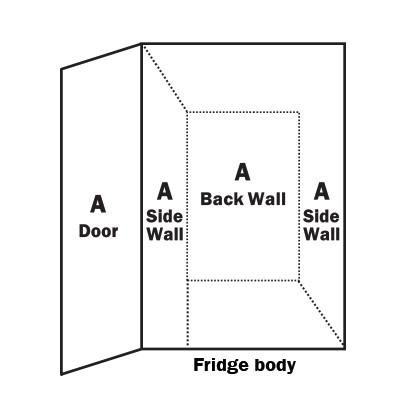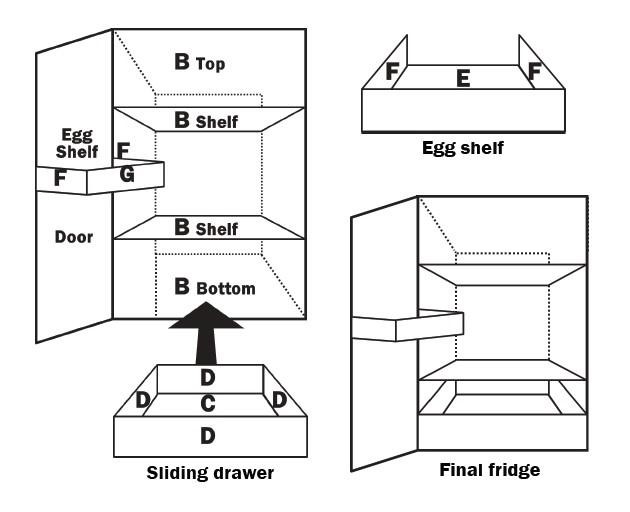
EBR-48 | August 2019
How to Build a Miniature Refrigerator for Nutrition & Food Safety Demonstrations
By Shauna C. Henley, Ph.D. and Trish Moore
How to use your miniature refrigerator:
The miniature refrigerator gives educators a portable refrigerator to use at workshops, health fairs and other public events as part of a nutrition and food safety demonstration.
- Collect fake food items to have youth or adults pretend they are putting groceries away in their refrigerator at home.
- Or the educator can stage the miniature refrigerator with safe and unsafe food storage for youth and adults to find. Unsafe food storage could be staging the eggs in the door or keeping an appliance thermometer with the refrigerator temperature at 80ºF.
This demonstration allows the educator to talk about safe food handling to prevent cross-contamination and make sure that home refrigerators are kept at the recommended temperature (under 4ºF) and freezer (under 0ºF) to prevent food safety risks and prevent food waste.

Final dimensions:
- The mini fridge will be 12” x 12” x 18”.
- Built with two shelves, pull out drawer and a shelf on the door for eggs.
Materials needed:
- Packing tape, glue gun or any other material to hold sides together
- Sturdy foam or plastic board Scissors or blade
- Ruler or cutting mat
The following are rough dimensions. You may need to make adjustments.
Main body and shelves of the fridge:
- A. 4 - 12” x 12” x 18” (door and walls)
- B. 4 - 12” x 12” x 12” (top, bottom and shelves)
Sliding bottom drawer:
- C. 1 - 11.5” x 11.5” x 11.5” (bottom drawer)
- D. 4 - 11.5” (length) x 2” (height) (drawer sides)
Egg shelf:
- E. 1 - 12” x 4” (base of shelf - may need to trim, so the door shuts)
- F. 2 - 1” x 4” (front and back of shelf of shelf siding. One side will need to be trimmed, so door shuts)
- G. 1 - 1” x 12” (side panel of the shelf)

Directions
- Gather supplies.
- Cutout refrigerator pieces A-G.
- Tape or glue the body of the refrigerator (along the 18” side), making sure one of your A panels is taped so the refrigerator can swing open to mimic an actual refrigerator door.
- Tape or glue all B panels to A. Shelving can be spaced as the educator sees fit.
- To create the sliding bottom drawer, tape or glue D panels to C. You may need to trim the C and D panels so the bottom drawer can easily slide out of the miniature refrigerator.
- To create the egg shelf on the door, tape or glue sides F and G to E.
- Tape or glue the egg shelf, so that the open side opposite of G is attached to the refrigerator door (panel A).
- Add decals or pictures as you see fit to the front of your miniature refrigerator door, to mimic a home personal refrigerator.
SHAUNA C. HENLEY, PH.D.
shenley@umd.edu
TRISH MOORE
pmoore@umd.edu
This publication, How to Build a Miniature Refrigerator for Nutrition & Food Safety Demonstrations (EBR-48), is a part of a collection produced by the University of Maryland Extension within the College of Agriculture and Natural Resources.
The information presented has met UME peer-review standards, including internal and external technical review. For help accessing this or any UME publication contact: itaccessibility@umd.edu
For more information on this and other topics, visit the University of Maryland Extension website at extension.umd.edu
University programs, activities, and facilities are available to all without regard to race, color, sex, gender identity or expression, sexual orientation, marital status, age, national origin, political affiliation, physical or mental disability, religion, protected veteran status, genetic information, personal appearance, or any other legally protected class.
When citing this publication, please use the suggested format:
Henley, S., & Moore, T. (2019, August). How to Build a Miniature Refrigerator for Nutrition & Food Safety Demonstrations (EBR-48). University of Maryland Extension. go.umd.edu/EBR-48